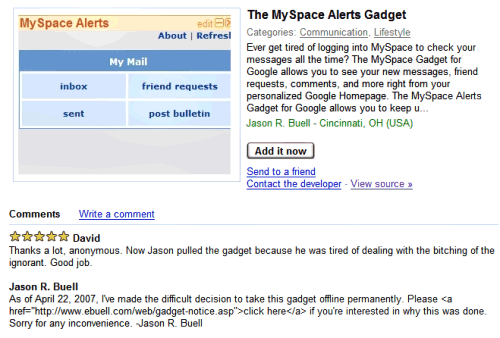Jason wrote a popular gadget that showed your MySpace alerts. Of course, the gadget required you to enter your MySpace username and password (ideally, MySpace should have an API for authentication and data).
"A few months back, a flaw was discovered whereby usernames were being passed in clear-text as a querystring parameter when using the gadget. As a result of Google's mechanism that caches web-content, a list of usernames on a phishing watchlist website was cached in Google's search index, thus making them publicly accessible. Once Google was alerted of the issue, they contacted me immediately. Google took action and removed the cached content from their search index, and I took numerous steps to strengthen the security of the gadget - and to mitigate any future risks. Google even went as far as to work with the operators of the phishing watchlist to remove my name and IP addresses from the suspected phishers list."
But people thought that the flaw was intentional and accused him of phishing. "Due to a common misconception that the Gadget was actually being used to facilitate phishing activity, I have decided to remove it permanently. This is a particularly difficult decision because of the large number of users and the popularity of this gadget."
Google shows a warning everytime you add third-party gadgets, so you should be careful when you add gadgets from unknown sources. You should be even more careful when you enter personal data.

No comments:
Post a Comment